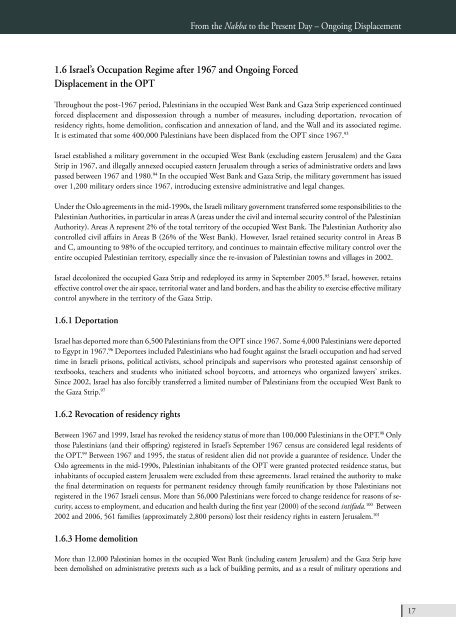BADIL Resource Center for Palestinian Residency and Refugee
BADIL Resource Center for Palestinian Residency and Refugee
BADIL Resource Center for Palestinian Residency and Refugee
Create successful ePaper yourself
Turn your PDF publications into a flip-book with our unique Google optimized e-Paper software.
From the Nakba to the Present Day – Ongoing Displacement<br />
1.6 Israel’s Occupation Regime after 1967 <strong>and</strong> Ongoing Forced<br />
Displacement in the OPT<br />
Throughout the post-1967 period, <strong>Palestinian</strong>s in the occupied West Bank <strong>and</strong> Gaza Strip experienced continued<br />
<strong>for</strong>ced displacement <strong>and</strong> dispossession through a number of measures, including deportation, revocation of<br />
residency rights, home demolition, confiscation <strong>and</strong> annexation of l<strong>and</strong>, <strong>and</strong> the Wall <strong>and</strong> its associated regime.<br />
It is estimated that some 400,000 <strong>Palestinian</strong>s have been displaced from the OPT since 1967. 93<br />
Israel established a military government in the occupied West Bank (excluding eastern Jerusalem) <strong>and</strong> the Gaza<br />
Strip in 1967, <strong>and</strong> illegally annexed occupied eastern Jerusalem through a series of administrative orders <strong>and</strong> laws<br />
passed between 1967 <strong>and</strong> 1980. 94 In the occupied West Bank <strong>and</strong> Gaza Strip, the military government has issued<br />
over 1,200 military orders since 1967, introducing extensive administrative <strong>and</strong> legal changes.<br />
Under the Oslo agreements in the mid-1990s, the Israeli military government transferred some responsibilities to the<br />
<strong>Palestinian</strong> Authorities, in particular in areas A (areas under the civil <strong>and</strong> internal security control of the <strong>Palestinian</strong><br />
Authority). Areas A represent 2% of the total territory of the occupied West Bank. The <strong>Palestinian</strong> Authority also<br />
controlled civil affairs in Areas B (26% of the West Bank). However, Israel retained security control in Areas B<br />
<strong>and</strong> C, amounting to 98% of the occupied territory, <strong>and</strong> continues to maintain effective military control over the<br />
entire occupied <strong>Palestinian</strong> territory, especially since the re-invasion of <strong>Palestinian</strong> towns <strong>and</strong> villages in 2002.<br />
Israel decolonized the occupied Gaza Strip <strong>and</strong> redeployed its army in September 2005. 95 Israel, however, retains<br />
effective control over the air space, territorial water <strong>and</strong> l<strong>and</strong> borders, <strong>and</strong> has the ability to exercise effective military<br />
control anywhere in the territory of the Gaza Strip.<br />
1.6.1 Deportation<br />
Israel has deported more than 6,500 <strong>Palestinian</strong>s from the OPT since 1967. Some 4,000 <strong>Palestinian</strong>s were deported<br />
to Egypt in 1967. 96 Deportees included <strong>Palestinian</strong>s who had fought against the Israeli occupation <strong>and</strong> had served<br />
time in Israeli prisons, political activists, school principals <strong>and</strong> supervisors who protested against censorship of<br />
textbooks, teachers <strong>and</strong> students who initiated school boycotts, <strong>and</strong> attorneys who organized lawyers’ strikes.<br />
Since 2002, Israel has also <strong>for</strong>cibly transferred a limited number of <strong>Palestinian</strong>s from the occupied West Bank to<br />
the Gaza Strip. 97<br />
1.6.2 Revocation of residency rights<br />
Between 1967 <strong>and</strong> 1999, Israel has revoked the residency status of more than 100,000 <strong>Palestinian</strong>s in the OPT. 98 Only<br />
those <strong>Palestinian</strong>s (<strong>and</strong> their offspring) registered in Israel’s September 1967 census are considered legal residents of<br />
the OPT. 99 Between 1967 <strong>and</strong> 1995, the status of resident alien did not provide a guarantee of residence. Under the<br />
Oslo agreements in the mid-1990s, <strong>Palestinian</strong> inhabitants of the OPT were granted protected residence status, but<br />
inhabitants of occupied eastern Jerusalem were excluded from these agreements. Israel retained the authority to make<br />
the final determination on requests <strong>for</strong> permanent residency through family reunification by those <strong>Palestinian</strong>s not<br />
registered in the 1967 Israeli census. More than 56,000 <strong>Palestinian</strong>s were <strong>for</strong>ced to change residence <strong>for</strong> reasons of security,<br />
access to employment, <strong>and</strong> education <strong>and</strong> health during the first year (2000) of the second intifada. 100 Between<br />
2002 <strong>and</strong> 2006, 561 families (approximately 2,800 persons) lost their residency rights in eastern Jerusalem. 101<br />
1.6.3 Home demolition<br />
More than 12,000 <strong>Palestinian</strong> homes in the occupied West Bank (including eastern Jerusalem) <strong>and</strong> the Gaza Strip have<br />
been demolished on administrative pretexts such as a lack of building permits, <strong>and</strong> as a result of military operations <strong>and</strong><br />
17

















